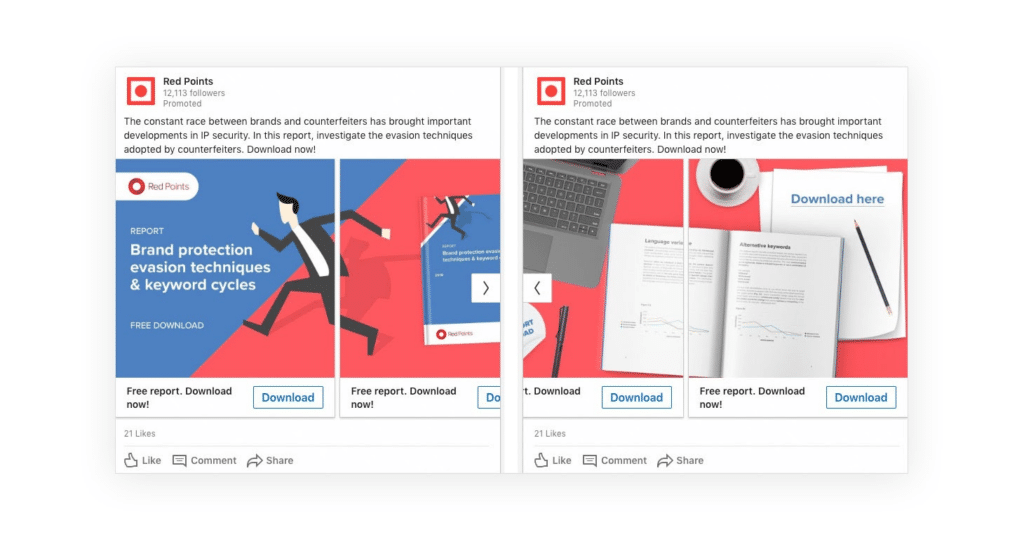SaaS Marketing Guide
SaaS demand generation: Framework, channels, and best practices
Book a FREE SEO Strategy Consultation >
Further Reading:
- SaaS Marketing Strategy
- SaaS Content Marketing
- SaaS SEO
- SaaS Account Based Marketing
- SaaS Email Marketing
- SaaS Inbound Marketing
- SaaS Retargeting
- SaaS Marketing Budget
- SaaS Marketing Plan
- SaaS Referral Marketing
- SaaS Demand Generation
- SaaS Customer Journey
- SaaS CMO Strategy
- SaaS link building
- SaaS Lead Generation
- SaaS Landing Page Examples
- SaaS CMS
- SaaS Customer Churn
- SaaS Marketing Automation
- SaaS Marketing Campaigns
- SaaS Marketing Agency
- SaaS SEO Agency
- SaaS Link Building Services
SaaS businesses can find it hard to market their products effectively. Software as a Service products can be complex and expensive as well as non-physical, making it difficult to generate interest from potential customers. That’s why you need a specific strategy for SaaS demand generation.
A demand generation framework for SaaS products provides a cohesive plan for all your marketing activities, showing you which tactics and channels to prioritize and optimize in order to continuously generate qualified leads and stand out from your competitors.
In this post, we‘ll explain exactly how to do that, including best practices for success, and explain why accelerate agency is best-placed to help you with SaaS demand generation.
What is demand generation?
Demand generation is the process of driving interest in—and increasing demand for—your company’s products or services. By doing so, you can attract and engage new prospects, who are then converted to leads and guided through th
e sales pipeline. Demand gen acts as a bridge between the marketing and sales teams.
This strategy combines multiple marketing techniques and channels, with touchpoints at every stage of the marketing and sales cycles (and beyond). It’s typically hyper-targeted and data-driven, with marketing content aimed at prospects who match your ideal customer profile.
Demand generation is often confused with lead generation, and there are some similarities. Lead generation is a part of demand generation, but it has a narrower focus on identifying prospective customers and capturing contact information for future marketing activities.
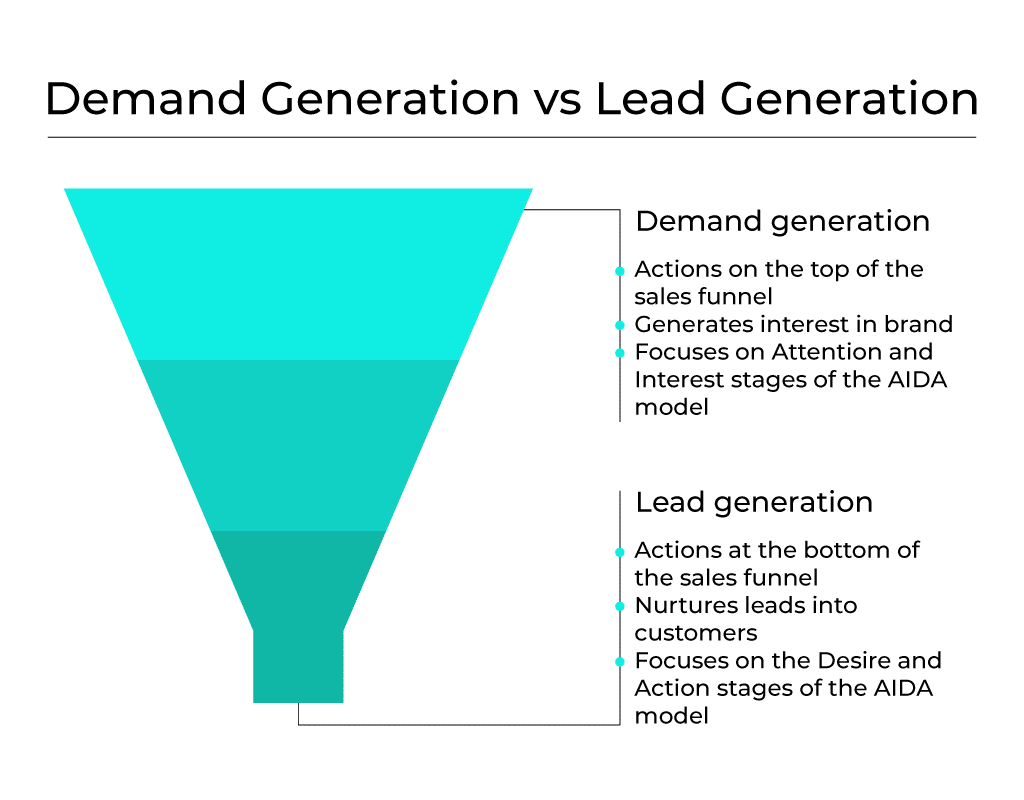
The definition of demand generation is different. It’s about using marketing and sales programs to create awareness and interest throughout the customer lifecycle, rather than just bringing leads into your pipeline. Although it doesn’t always result in more leads, it encourages leads to convert at a higher rate or a higher value.
The demand generation team would typically comprise members responsible for marketing operations, content marketing, digital marketing, event marketing, and design. Processes include converting anonymous traffic into known leads, driving qualified traffic to the website, nurturing leads toward purchase, retaining customers, and upselling additional products or services.
SaaS demand generation
Companies selling Software as a Service solutions need an SaaS-specific approach to demand generation.
For one thing, most SaaS firms are in the B2B market, and selling to other businesses is already a different ball game than selling B2C. For another, SaaS products can be harder to promote because they’re not physical. And the target audience may be spread across several different industries.
Plus, the buying cycle for B2B SaaS products typically requires multiple stages of buy-in from leadership and key decision-makers—making it longer than that of many other B2B services. That means you need to start demand generation for software well before a prospect is ready to make a purchase.
Because there’s no physical product to look at, SaaS demand gen is about building trust and educating potential customers about the benefits of your software. This involves creating online content such as blog posts, eBooks, and webinars—and using various strategies and channels to help people find it.
Why is demand generation important?
Demand generation for SaaS helps you to fill the top of your sales funnel with potential leads who are already aware of your brand, products, and services. It also enables marketing teams to qualify them with lead scoring. That’s why successful demand generation programs result in more Marketing Qualified Leads (MQLs), Sales Qualified Leads (SQLs), and higher conversion rates.
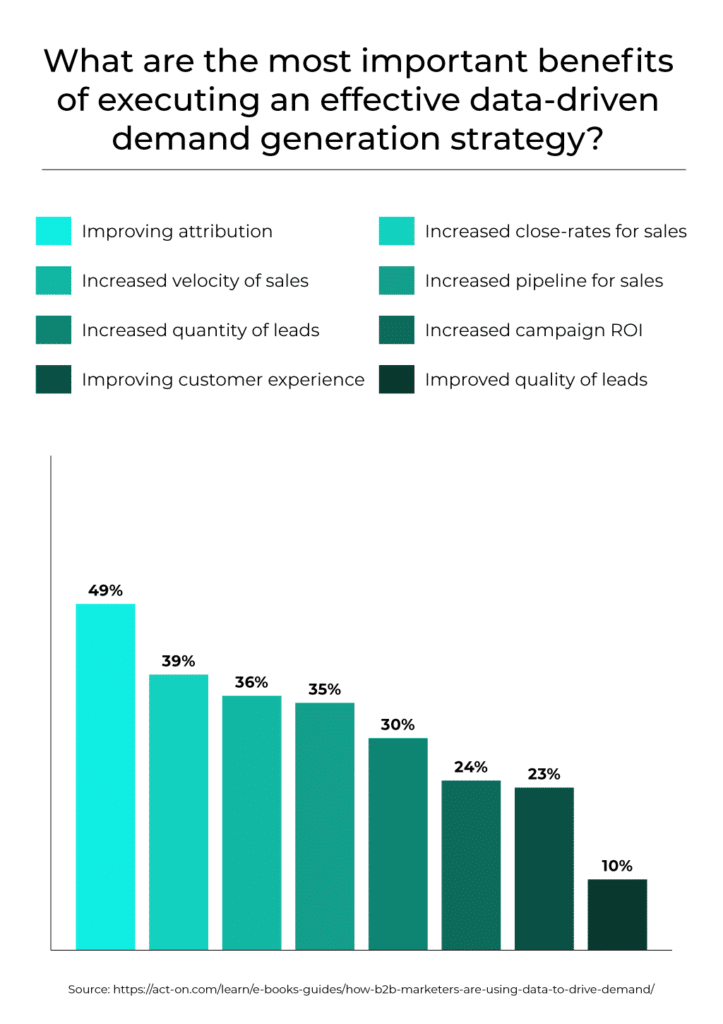
Increased awareness gives your target audience a better understanding of your product and whether or not it will meet their needs. By building awareness, you can get people talking about your brand—so even if they don’t need to buy the software right now, they’ll remember you when they do.
Demand generation supports your lead nurturing process, which is all about building trust. You’ve already done enough to draw prospects into your pipeline, but when they continually see your product mentioned in content around the web, that’s a strong form of social proof.
This drives more traffic to your website, made up of people who are already engaged. And with higher levels of engagement, your marketing teams can learn more about your prospects and tailor the messaging to their needs.
As well as identifying new and existing opportunities, demand generation means you can easily track ROI and spot bottlenecks at every step of the sales funnel.
SaaS demand generation framework
As we’ve seen already, SaaS demand generation is a multi-stranded task, and the best way to tackle it is to put a standardized system in place. Because every business will have slightly different needs, there’s no such thing as a one-size-fits-all strategy.
For example, some businesses will focus on inbound marketing while others use outbound, and demand generation tactics will differ by channel. But the demand generation framework shown here is applicable to most SaaS businesses.
It’s also scalable and self-growing. You can add different channels as your marketing team expands, and as you invest time and resources. The more traffic you drive to your website, the more data you’ll collect, which you can use to personalize your marketing and run future campaigns.

Target audience
Firstly, you need to know who you’re trying to reach.
You can create buyer personas to represent your ideal customer, and imagine their needs and pain points. How would your SaaS product make their lives better? Once you know as much as possible about your target market, you’ll be able to create marketing messages aimed squarely at them.
Brand positioning
In SaaS, it’s hard to differentiate your company from the many vendors offering similar solutions. Research your main competitors, and consider how your product offering is different in terms of who it helps, how it works, and what problems it solves. What’s your reason for existence?
Use your buyer personas to think about the challenges of your potential customers, and position your brand as the only one that can meet them—as well as subtly pointing out what will happen if they don’t choose you.
Channel selection
Now you need to think about the channels you’ll use for demand generation, both for inbound and outbound marketing. This will depend on your target audience and also your budget, especially if you’re planning to use paid advertising as part of the channel mix.
Digital channels may include social media, PPC ads, email marketing, and SEO. You could use traditional avenues such as billboards, print ads, and TV commercials, or think about sponsoring a podcast. Don’t forget that your website is a channel in itself, so site optimization is a must.
Content strategy
Content marketing is a big part of SaaS demand generation, as it helps you to prove the worth of an intangible product. You need a specific content strategy as part of the demand generation framework, factoring in the kind of content that will appeal to your target market.
Thought leadership pieces are essential, alongside product comparison articles and industry news—all paying attention to SEO so that people can find your content easily. You can either produce content in-house, or appoint experts (like accelerate agency) to create it for you.
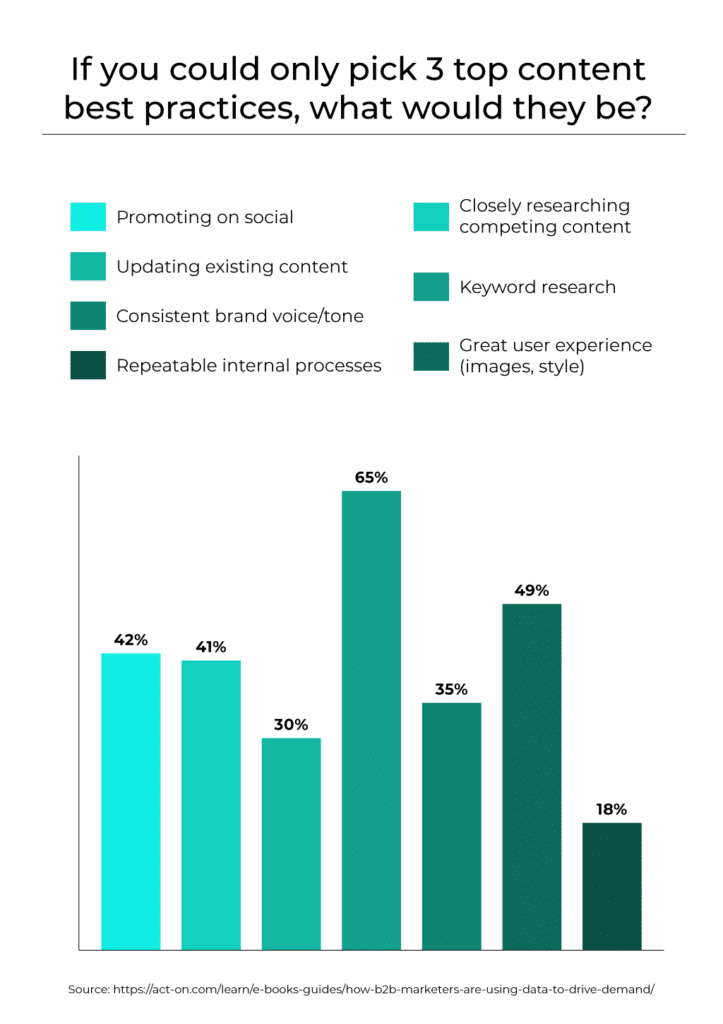
Customer database
It’s vital to have a CRM system in place, so that you can easily store data about your prospects and customers.
For example, when someone gives you their email address in exchange for an eBook or whitepaper, you can store this alongside details of their browsing habits. If they contact you—whether to ask for more product details or with the intent to buy—you can keep a record of the interactions.
As you build up a picture of the customer, you can run more targeted ad campaigns.
Sales cycle
You also need a system for handing leads over from the marketing team to your sales reps—and kick-starting the sales cycle.
Once a prospect has requested a product demo or a free trial, the goal is to book a meeting—either in person or virtually.
Sales development reps are usually the ones who follow up with email and phone calls to qualify the lead and ensure the product will address their needs. The marketing team also supports the sales process with continuous content, and maybe by holding events where prospects can meet other customers and company leaders.
Retargeting
Any closed-lost prospects get pushed back to the top of the funnel, where the marketing team takes over again.
This is where you can use retargeting (or remarketing) to show specific ads to those who visited your website but didn’t take the required action—such as giving you their email address.
Retargeting ads aim to drive them back to your website and get them to sign up for top-of-funnel programs like newsletters, from where you can guide them toward a demo.
Results analysis
Just like any strategy, it’s important to measure the success of your demand generation framework to make sure it’s having the desired effect and that you’re getting a good ROI for your efforts.
It’s good practice to create monthly reports that track your growth and successes, like accelerate agency does for its clients. If something isn’t working, you can experiment with different strategies and tactics.
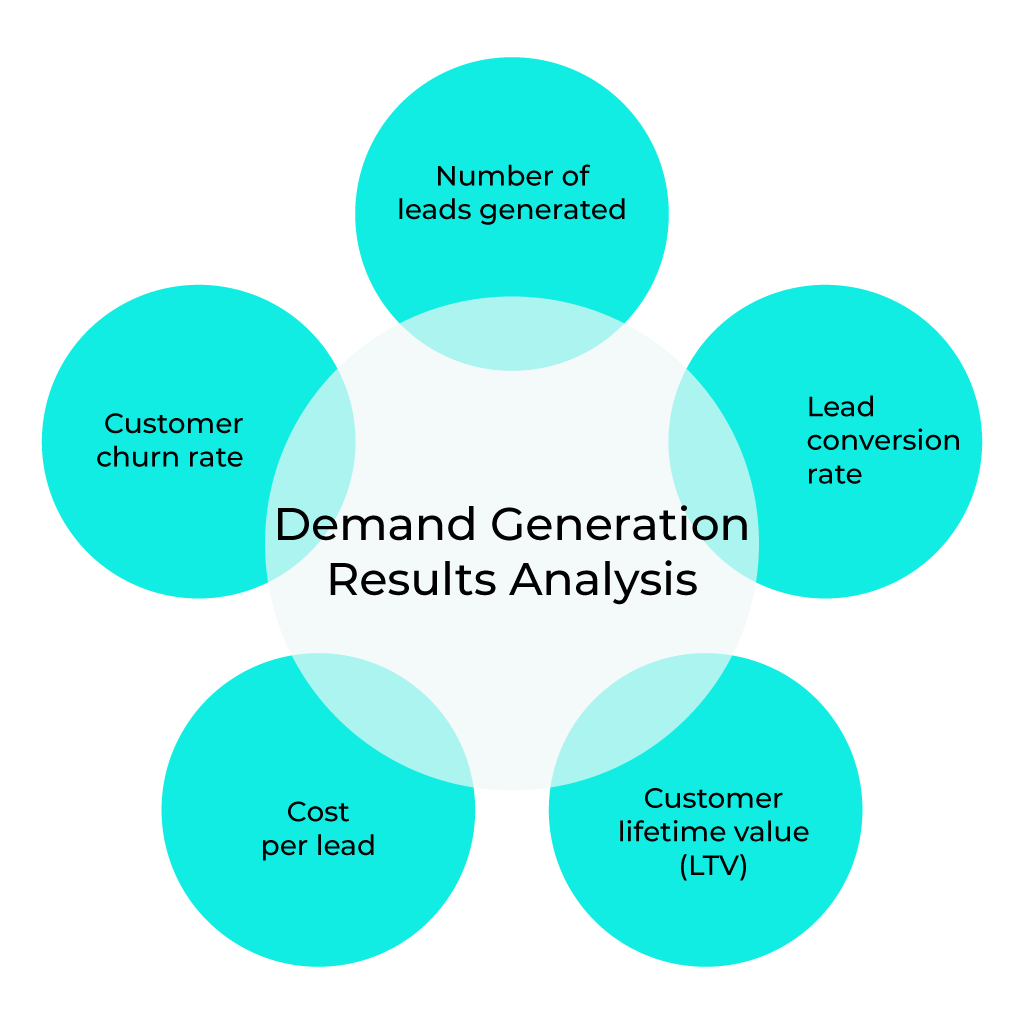
Key metrics include number of leads generated and lead conversion rate. Obviously, you should be generating as many leads as possible, and converting as many as possible into paying customers. High figures in these categories point to effective demand generation.
Another crucial metric to measure is customer lifetime value (LTV) or how much revenue you can expect to generate from a customer throughout their lifespan as a patron of your company. Again, a higher figure is better.
You should also check out cost per lead (how much it costs you to generate each lead) and customer churn rate (the percentage of customers who cancel their subscriptions or stop using your product). In both these categories, you’re looking for a low figure.
Demand generation channels for SaaS companies
We briefly mentioned channel selection earlier, but it’s getting its own section here because it’s so important.
In the interest of displaying your messaging and content to a wide audience, you might be tempted to use as many channels as possible, but you need to make sure they are relevant to your potential customers.
With SaaS, you’re targeting fellow businesses with a non-physical product, so there’s not so much use for visual, youth-focused mediums like Instagram or TikTok.
Website
Website optimization is your first step. Your website is where people will head if they want more info about your company, and they’ll also find it through organic search or PPC ads (more on those later).
Giving a good first impression is vital, so think inspiring design, fast-loading pages, professional images, and clear navigation—plus plenty of calls to action.
Let’s start with landing pages, which should be tailored to the target user’s level of awareness about your product or service. Some customers are actively seeking a solution, while others don’t yet know they have a problem. Still others are aware that similar solutions exist, and are looking at their options.
If they’re not yet solution-aware, your landing page needs to guide them in the right direction. Educate them, offer a lead magnet, and direct those who download it to a thank you page with a sign-up form for a demo or a free trial. Don’t forget to send a follow-up email.
Those who are solution-aware are typically people who’ve already engaged with your ads, downloaded lead magnets, viewed your pricing pages, or searched for reviews of your product or brand. They should be seeing a landing page that goes straight to offering them a trial or demo.
Also pay attention to your homepage. Even here, you should be speaking to a specific target audience and clearly communicating your value proposition.
Use a headline that asks a question, to make visitors think about their pain points and realize that they need a solution. Briefly state the key benefits of your product and add a couple of testimonials from high-profile clients.
Product feature pages come next, and should be designed to address questions like: “Does the product match what I’m searching for? Can it solve my problems? Is it a worthwhile investment? And what should I do next?”
This is where you can provide more information on the individual features and what a customer might use them for. Prospects also need reassurance that they can trust the product, so include testimonials and case studies from businesses that use your SaaS product.
If people want more context, they can head to your blog page, which should tread the fine line between offering lots of relevant content while not being too overwhelming—like the example below from accelerate agency’s own blog page:
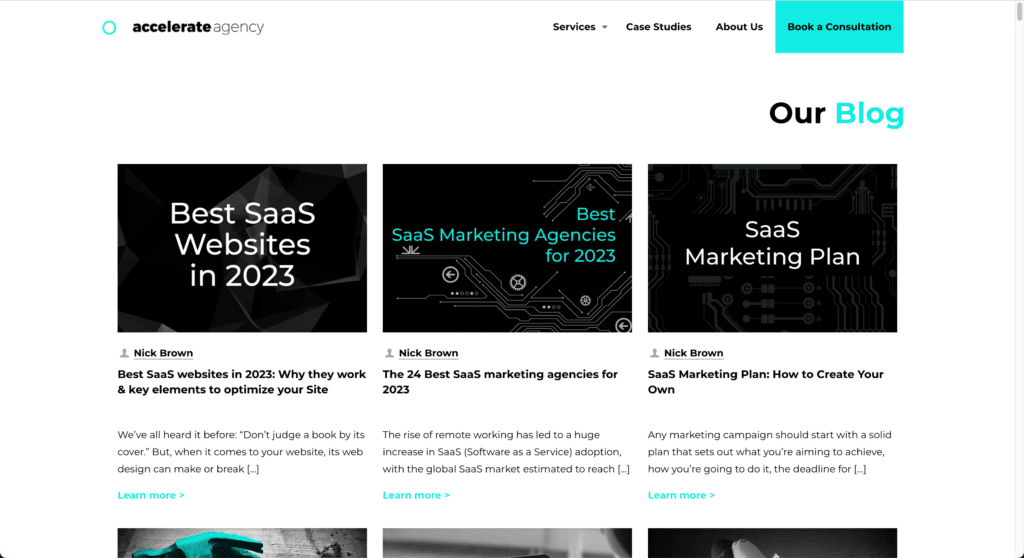
Make your blog homepage searchable, and state the publishing date of each article (this also helps with search engine algorithms that favor fresh content). Include CTAs, interspersed through the copy and reinforced at the end.
The all-important pricing page should present your plans in the simplest way possible, to make it easy for prospects to compare the features and figure out which is the best fit for their needs.
Make it clear whether the prices are monthly or annual, and enable visitors to display them in different currencies. If your pricing is bespoke, encourage prospects to click or call for a chat with a rep.
Don’t forget to optimize your About, Contact Us, and Support pages so that visitors can easily find more information and get in touch.
Search Engine Optimization (SEO)
The importance of SEO in SaaS demand generation cannot be overstated. If your website and content isn’t optimized effectively, even prospects with real buying intent will struggle to find you online. You’ll be missing out on sales opportunities.
SEO can be broken down into three parts:
- Technical SEO deals with the technical specifications and structure of your website. Issues like crawl errors and slow-loading pages make it harder for search engines to read your pages, which means they won’t rank so highly in the results pages.
You also need to ensure that your pages are relevant to the topic that users are searching for. As well as appeasing the algorithms, an error-free website is also important for the user experience. - Content marketing is also an important aspect of SEO. The search engines favor fresh, high-quality articles, so refresh and update your content as often as you can (and get rid of any underperforming pages).
Keep it relevant by matching content to different stages of the buyer’s journey. You should always focus on delivering value as well as information, so don’t create content for the sake of it.
Search engines also prefer pages that have depth, so you don’t necessarily need to create a new blog whenever you add a new feature or benefit to your product.
It’s better to consolidate existing pages where possible, combining those that cover the same topics. It should be easy for visitors to navigate through your website and find the content they’re looking for.
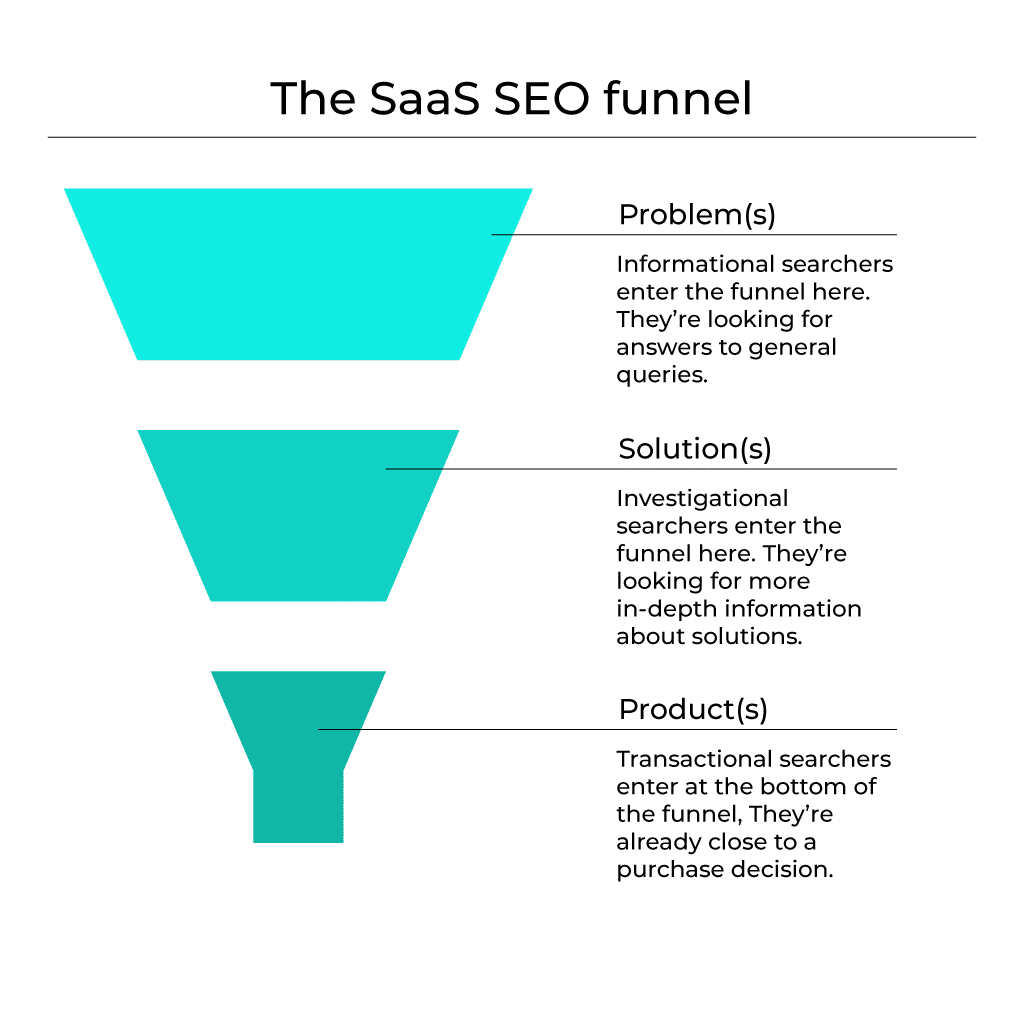
- Finally, SEO outreach involves building relationships with relevant publishers, such as authoritative websites and influencers who will recommend your brand to their existing audiences.
The key is to create content that other people want to link to and share—and to keep an eye out for backlink opportunities. Tools like Ahrefs will create alerts whenever there’s a mention of your brand somewhere on the web. Meanwhile, accelerate agency regularly secures links from top websites for its clients.
PPC ads
In addition to organic search, you might decide to use paid advertising in the form of pay-per-click. This strategy relies on finding the right customer-channel fit, so that your ads run on the right platforms and match the target user’s behavior and intent.
Here are some of the platforms you can use (including for retargeting ads):
- Google Ads: You can choose who sees these ads based on specific factors. For example, you might tell Google to show a certain ad to anyone whose search history shows strong purchasing intent over the past two weeks. Using managed placements also enables you to choose the websites where your ads will appear.
You can target brand keywords such as “brand name + reviews” or “brand name + pricing”. If you combine existing customer or pipeline data with keyword targeting, you can reach a more precise group. - LinkedIn Ads: LinkedIn is more expensive than Google and tends to generate fewer leads, but they’ll typically be higher in quality. You can target users by industry, company, and job title, in order to aim at key decision-makers who are tasked with sourcing new software.
However, bear in mind that most people who use LinkedIn are primarily there to network with other professionals, rather than to purchase anything. It’s useful to steer them toward lead magnet downloads at this stage, instead of free trials. - Facebook Ads: Facebook enables you to use hyper-specific targeting. You can create “lookalike audiences” based on existing customer and prospect data, and retarget previous customers of your product. The platform also lets you build custom audiences based on relevant interests and behaviors, but that’s less applicable to B2B SaaS.
Whichever platform you choose for PPC ads (or maybe a combination of them all), it’s good to set benchmarks. Work out your total ad budget, set your customer acquisition goal, and the total number of clicks required to reach it.
You can then determine a target cost per click, based on the average customer LTV and the number of closed deals you want to achieve each month.
Account-based marketing
A SaaS account-based marketing strategy sees you narrow your targeting to a list of those who represent a great fit for your product and brand.
By singling out these potentially high-value customers, you can aim your content directly at them. However, this content can be more sales-focused, as you’re trying to generate leads and conversions rather than providing readers with valuable insights and thought leadership.
Account-based marketing (ABM) includes sending emails and direct mail, phone calls, and uploading your database list to reach your audience on ad platforms that use matching. It typically has a higher CAC (Customer Acquisition Cost) than the more generalized styles of marketing.
Email marketing
Email marketing is popular because it’s a low-cost strategy but has a high ROI. It focuses on developing awareness by reaching out to your prospects and providing value.
Segment your email list by industry, position, or company so that the messages are specifically relevant to each recipient. Always include a clear CTA.
Having collected email addresses from website visitors who downloaded your lead magnets (or people who have previously used your product), you’ll be targeting folks who already know your brand. It’s useful for account-based marketing, when you’re connecting with targeted high-value accounts.
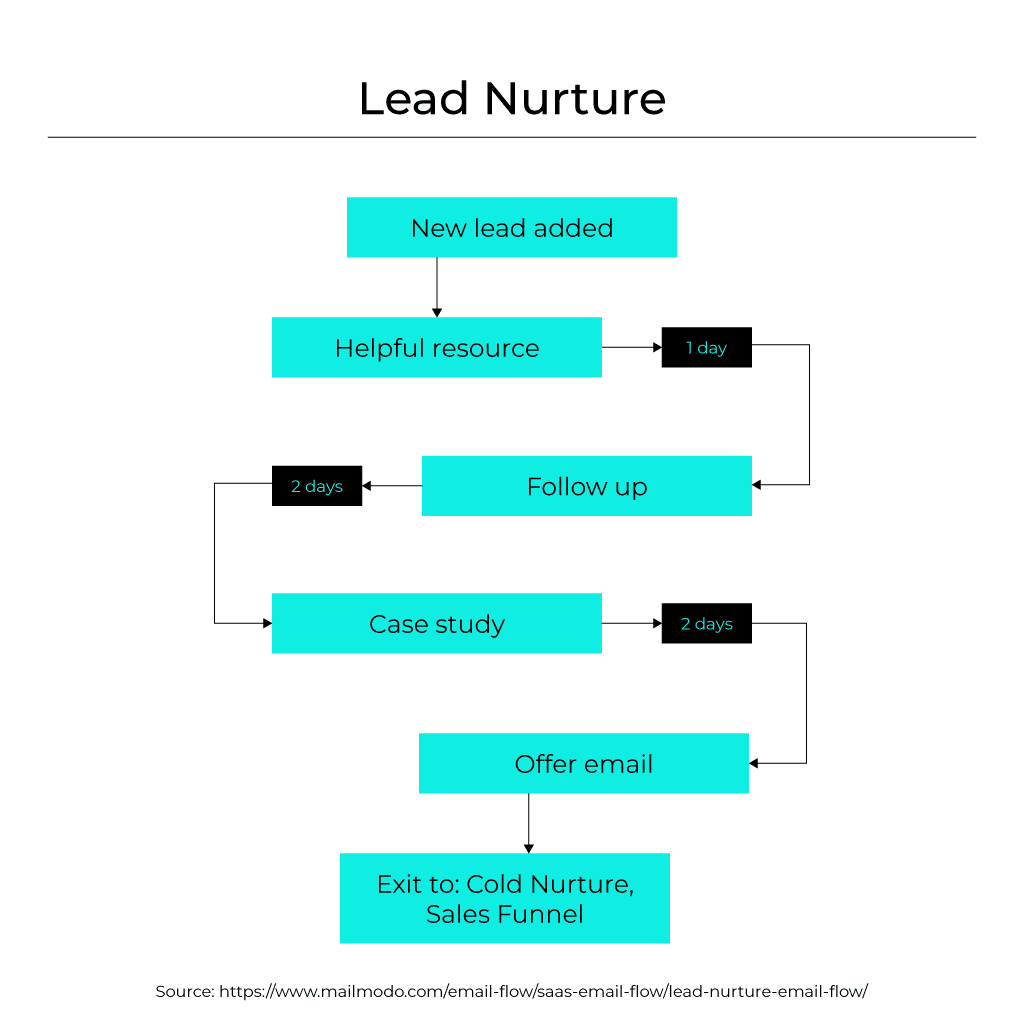
Email is used for lead nurturing rather than lead generation, as people with no connection to your brand won’t appreciate receiving cold-pitch emails and will regard them as spam. Not only does this bring low conversion rates, it could actually damage your reputation.
Even when you have a reason to send emails, be careful with the frequency so that the recipients don’t feel bombarded.
Webinars
Webinars are a good way for SaaS businesses to identify and nurture their most engaged audiences.
This method is direct and personal, and gives your prospects the chance to see your leadership face-to-face. You might take the opportunity to demonstrate your product and instruct attendees on how it works, or educate them on relevant industry topics.
Webinars enable you to reach a bunch of people at once, potentially from all over the world. But take care not to invite too many, as the event won’t seem so intimate. You want people to feel like they’ve been selected because the product’s a great fit for them.
Referrals
Referrals from happy customers are a form of marketing that’s effectively cost-free—and leads generated from word-of-mouth recommendations are often of higher quality than those that come through paid programs.
How to get these precious referrals? Make sure that all customers, from their first contact with you to the after-sales experience and beyond, have a positive brand and product experience.
You should also make it easy for them to tell others about you. Once they’ve made a purchase, ask for a testimonial or direct them to review sites.
Best practices for a successful SaaS demand generation
So, now you know how to create a demand generation framework, and choose the right channels for SaaS demand generation. But how do you ensure your activities are successful?
You can follow the best practices outlined below. (And to supercharge your demand gen, you could hire a specialist agency to help you.)
Ensure product-market fit
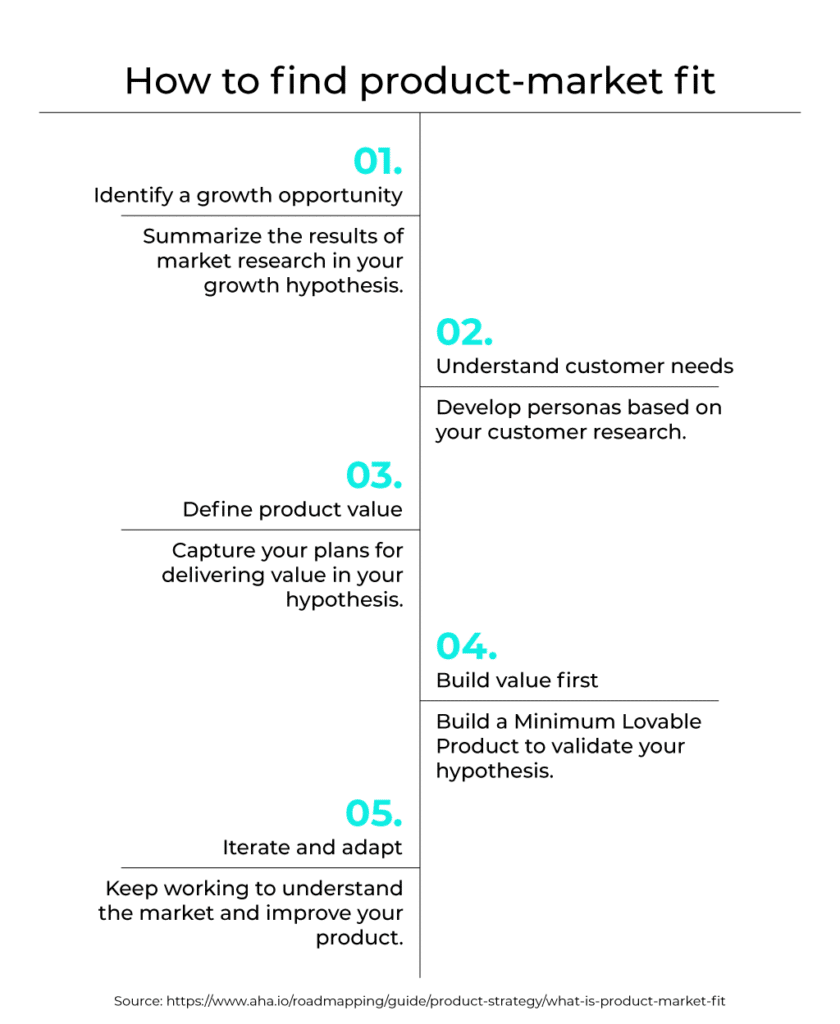
Before you get started on choosing channels and creating strategies, take some time to consider product-market fit.
This basically means that your product solves a particular problem for a particular type of customer, and that this customer will be happy to pay the price you’re charging. And it means that you need to know your target audience and keep a sharp focus on what they want. It’s about knowing who to target, how, and when.
Hyper-targeting
Hyper-targeting naturally follows on from product-market fit. Your ideal customer profile gives you a niche to target through the right channels and messaging. For example, don’t just target “medium-sized businesses”—focus on companies within a specific industry, location, and annual revenue bracket.
You also need to identify people who fit your ideal customer profile but are at different stages of the buying journey.
From there, you can segment your accounts into sections or tiers. Once the lists are segmented, it’s possible to create account-based marketing campaigns, reaching businesses in each of the tiers at the right stage in the buying process.
Content strategy
Quality content is a major part of SaaS demand generation. Keep it relevant to the needs and challenges of your target customers, answer their questions, and provide value. It’s also vital that you maintain a consistent brand voice and identity, to generate trust in your business and product.
Carry out SEO keyword research, including long-tail keywords, to discover the terms people tend to use when searching for your product or something related to it. Then use those words and phrases in your content—but don’t stuff them in at the expense of readability and credibility. Remember that your content also needs to be placed on high-authority websites.
Lead nurturing strategy
It’s important that your demand generation efforts include effective lead nurturing. Since the B2B SaaS buying cycle is longer than it is for other products, you need your brand to remain top of mind for prospects over many weeks and even months.

You must communicate with leads at each stage of the journey, including providing personalized content and information related to their industry. As well as onsite content such as blogs, you could run an email drip campaign with a free trial offer. Just make sure you avoid sounding too salesy.
Efficient lead flow
Be aware of the different stages in the sales and marketing funnel, and create an efficient process for transferring leads to the sales team. The top of the funnel is about building awareness, while lead nurturing happens in the middle of the funnel, before qualified leads move into the sales process.
It’s also worth carrying out an audit of your current sales funnel, to see where leads are falling by the wayside and figure out what you can do about it.
Are people clicking your ads but not taking the next step, or quickly bouncing when they land on your website? How many leads are converted into customers, and how many of those are actually paying for your product?
Tracking and attribution
If your marketing spend is failing to generate the expected ROI, it could be that your funnel is not being mapped effectively. Part of your audit should involve tracking the lead-to-revenue funnel and finding out what’s happening to new leads—are they being placed in a queue but never followed up?
It’s also important to track and attribute leads and conversions, so that you can see which strategies or pieces of content are paying off.
By monitoring data and performance, you can ditch pages that don’t work, and you’ll know what to prioritize for future campaigns.
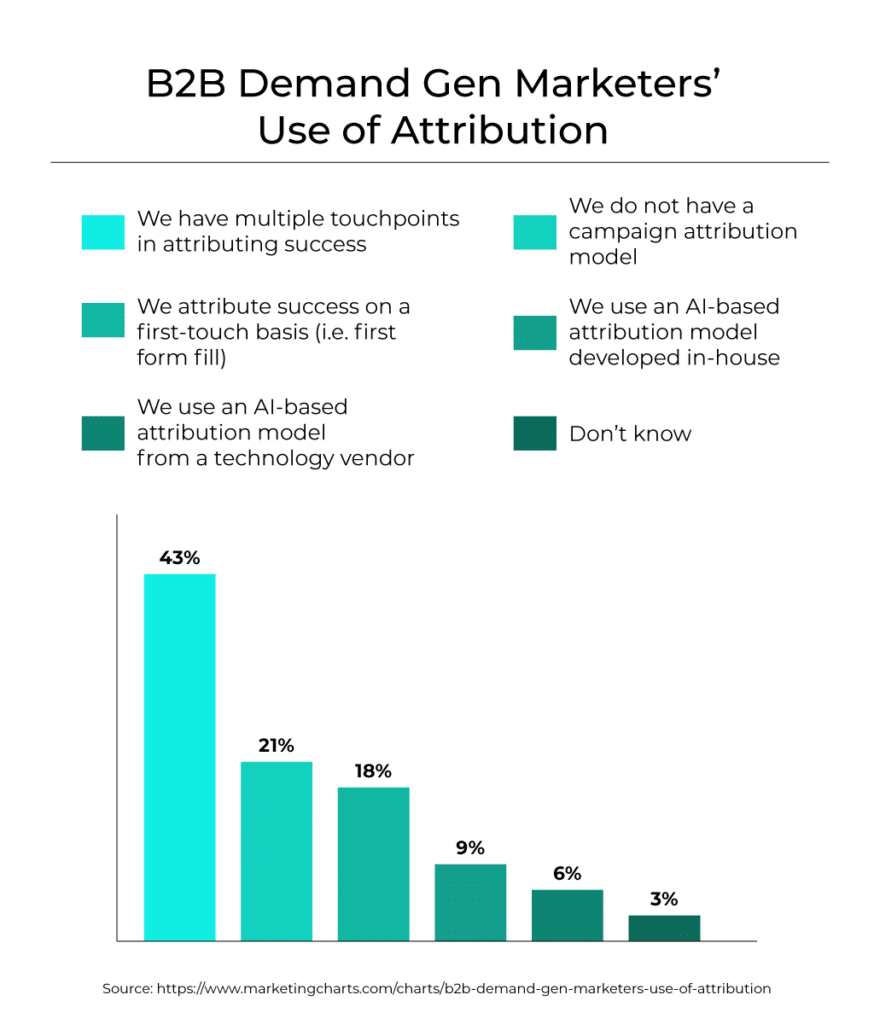
Team collaboration
Strong collaboration between the sales and marketing teams is essential, and it’s best if they can work together right from the get-go, with shared goals and definitions.
This includes identifying ideal customers and creating profiles, as well as a list of target accounts and customized tactics. Sales development representatives (SDRs) play an important role here, acting as a bridge between marketing and sales.
Testing
To evaluate the success of your SaaS demand generation activities, it’s important to track every marketing touchpoint throughout the funnel.
If you discover that certain channels or strategies are not working well, you can run some tests to see what makes a difference. Test multiple channels with a small budget to find the best ones, then scale those with the highest ROI.
Automation
Marketing automation and artificial intelligence are used increasingly in the world of demand generation. These technologies help you to speed up repetitive tasks such as lead scoring, and create workflows for things like email marketing to nurture prospects before they’re ready to connect with a sales rep.
You can also use AI for data collection and analysis (like accelerate agency does), in order to create more relevant content.
Build effective SaaS demand generation with accelerate agency
SaaS demand generation takes plenty of time and effort to be successful—so it makes sense to get some expert help from a specialist SaaS marketing agency.
accelerate agency uses a combination of human expertise, data, and machine learning to get results through strategic SEO, content creation, large-scale outreach, and link building.
Firstly, accelerate agency will perform an in-depth review of your website, to ensure it’s working for you at every stage of the sales funnel—and to identify new opportunities. This includes a competitor intelligence report and thorough keyword gap analysis.

accelerate agency knows the importance of technical and onsite SEO, so the review will cover everything from page speed to internal linking. As well as improving the website experience for prospects and customers, this ensures that search engines will see your content as authoritative (which gives it more chance of showing up in rich snippets).
Next comes link building and outreach, which is where accelerate agency really stands out from the competition. Thanks to long-standing content partnerships, we can secure links from top authority SaaS-related websites, which are required for your own website to rank highly in competitive search terms.
As you know, it can be tricky to ensure your content reaches the right people at the right time, while staying relevant to the target audience. accelerate agency produces data-driven, purposeful onsite content that’s designed to meet your users’ various search intents—all the way through from inquiry to consideration to purchase and retention.
You can hire accelerate agency to work as an extension of your marketing team, or to provide content on your behalf.
Either way, you can expect to see significant growth, as have major SaaS clients like Dialpad and Databricks. The ambitious SaaS SEO strategies generate continual month-on-month PQL and MQL growth, as well as driving MRR.
